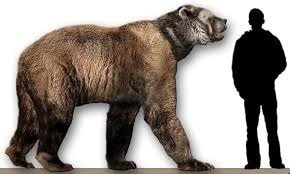The SHORT-FACED BEAR is an extinct giant species that inhabited Nebraska until around 11,000 years ago. It was the most common early North American bear, and most abundant in California. Around Lubbock Lake, in Texas, is the only evidence ever found, of humans butchering a short-faced bear. There are two recognized species: Arctodus pristinus and Arctodus simus, with the latter considered to be one of the largest known terrestrial mammalian carnivores that has ever existed. The average short-faced bear stood 8–10 feet tall on its hind legs, while a large specimen would have been 11–12 feet tall, with a 14-foot vertical arm reach. When walking on all fours, it stood 6 feet high at the shoulder, tall enough to look a man in the eye. It is estimated to have weighed in excess of 2,000 lb.s. At Riverbluff Cave, in Greene County, Missouri, a series of claw marks 15 feet high have been found along the cave wall. A. simus was suggested to have been highly carnivorous and as an adult would have required about 35 lb.s of flesh per day to survive.



No comments:
Post a Comment